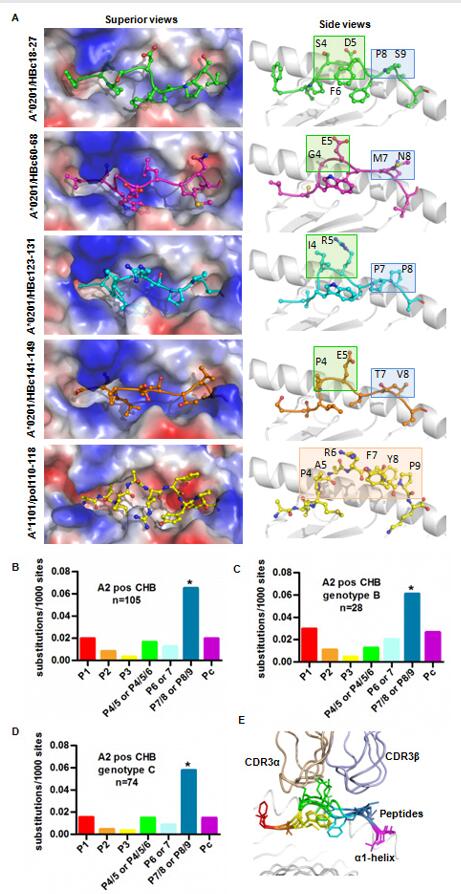Hepatitis B virus (HBV) chronically infects about 72 million people in China, which is associated with a much higher rish for progressive cirrhosis, liver failure, and hepatocellular carcinoma. It is a great threat to the health of human and can cause huge losses to our society. The virus-specific cytotoxic T lymphocyte (CTL)-meidated immune responses play a dominant role in determination of disease progression and outcome, while HBV can evolve by mutations to avoid immune clearance of CTL response resulting in chronic virus infection and immune evasion. Therefore, studies on specific patterns of T cell immune evasion can help for design of therapeutic vaccine and development of new antiviral strategy.
In this study, a tight correlation of the accumulated variants on HBV core protein (HBc) with the disease severity of HBV infection was observed based on analyses of clinical samples. Besides, by utilizing the function of antigen presentation and activation of T cell associated with heat shock protein gp96, a series of CD8+ T cell epitopes and its dominant variations were identified by immunologic analysis and structure determination. We elucidated that the mutations in these well-defined HLA-I restricted T-cell epitopes significantly decreased antiviral activity-specific CTLs and were positively assciated with clinical parameters and disease progression in HBV-infected patients. The molecular pattern for viral epitope variation based on the sequencing of HBV virus genomes indicated that the C terminal protion have the highest mutation rates. Further structural analysis of HLA-A*02 complexed to diverse CD8+ T-cell epitopes revealed that the highly-variated C-terminal bulged peak of “M-shaped” HBc-derived epitopes are solvent exposed and majorly hovered over by the CDR3b of the T-cell receptor (see Figure below). These data shed light on the molecular and immunological mechanisms of T-cell immunity-associated viral evolution in the hepatitis B progression, which is beneficial for designing immunotheraies and vaccines using gp96 as adjuvant.
These findings were published on latest issue of Journal of Virology. The first authors of this paper are Yu Zhang and Yan Wu, and the corresponding authors are Prof Songdong Meng and Porf. Jun Liu from China CDC. Several research teams from CAS Key Laboratory of Pathogenic Microbilogy & Immunology participated in this study. This work was supported by grants from Major State Basic Research Development Program of China, strategic Priority Research Program of the Chinese Academy of Sciences, National Natural Science Foundation of China and One Belt and One Road International Science and Technology Cooperation of Chinese Academy of Sciences.
This the third paper about the underlying mechanism of the immune pressure-associated HBV mutation of T-cell epitopes and their linking to the disease progression. The previous findings have already been published on Journal of Virology (2013) and Protein Cell (2014). Prof. Meng’s Lab has insisted in studying immunologic and biological fuctions of heat shock protein gp96 for the last twenty years and formed their own features and core techniques. These findings not only suggested that strong specific T cell response is crucial for clearing chronic HBV infection and functional cure of chronical hepatitis B (CHB), but also indicated that therapeutic vaccine companion with gp96 as adjuvant may help for developing new strategy for the treatment of CHB.

Contact:
Prof. MENG Songdong
CAS Key Laboratory of Pathogenic Microbiology and Immunology,Institute Of Microbiology,Chinese Academy of Sciences,100101,Beijing, China
E-mail: mengsd@im.ac.cn